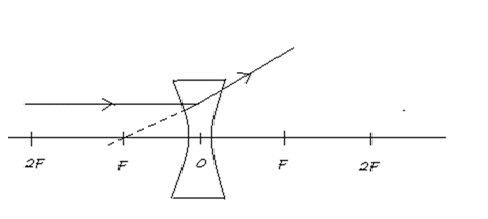
Redraw the diagram given below and complete the path or ray.


Answer
574.5k+ views
Hint:When the parallel rays of light pass through a concave lens to the principal axis, it deviates from its focal length. Also, when a ray passes through a focal point through a convex lens it goes parallel to the principal axis.
Step by step solution:
For part A: The given lens in figure A is concave. A concave lens is a diverging lens meaning that it spreads out light rays that have been refracted through it. A concave lens is thinner at its center than at its edges.
In the given figure A, the incident ray is coming from the infinity, that is the object is at infinity. The rays diverge from the focal center and an imaginary line is passed through the focal center as shown below:

When an object is placed at infinity, a virtual image is formed at the focus. The size of the image is much smaller than that of the object.
For part B: The given lens in figure B is convex. The convex lens is a lens that converges rays of light that convey to its principal axis which is relatively thick across the middle and thin at the lower and upper edges.
In figure B the incident ray is passing through the first focus (F). Whenever a ray is passing through the focus it will go parallel to the principal axis as shown below:

The image of the object will be formed at infinity in this condition.
Note:The action of the convex lens is to collect the light rays at one point. On the other hand, rays falling on the concave lens, after refraction at both surfaces of the lens, become more separated. Thus a concave lens produces spreading in the light rays.
Step by step solution:
For part A: The given lens in figure A is concave. A concave lens is a diverging lens meaning that it spreads out light rays that have been refracted through it. A concave lens is thinner at its center than at its edges.
In the given figure A, the incident ray is coming from the infinity, that is the object is at infinity. The rays diverge from the focal center and an imaginary line is passed through the focal center as shown below:

When an object is placed at infinity, a virtual image is formed at the focus. The size of the image is much smaller than that of the object.
For part B: The given lens in figure B is convex. The convex lens is a lens that converges rays of light that convey to its principal axis which is relatively thick across the middle and thin at the lower and upper edges.
In figure B the incident ray is passing through the first focus (F). Whenever a ray is passing through the focus it will go parallel to the principal axis as shown below:

The image of the object will be formed at infinity in this condition.
Note:The action of the convex lens is to collect the light rays at one point. On the other hand, rays falling on the concave lens, after refraction at both surfaces of the lens, become more separated. Thus a concave lens produces spreading in the light rays.
Recently Updated Pages
The number of solutions in x in 02pi for which sqrt class 12 maths CBSE

Write any two methods of preparation of phenol Give class 12 chemistry CBSE

Differentiate between action potential and resting class 12 biology CBSE

Two plane mirrors arranged at right angles to each class 12 physics CBSE

Which of the following molecules is are chiral A I class 12 chemistry CBSE

Name different types of neurons and give one function class 12 biology CBSE

Trending doubts
Which are the Top 10 Largest Countries of the World?

What are the major means of transport Explain each class 12 social science CBSE

Draw a labelled sketch of the human eye class 12 physics CBSE

Differentiate between insitu conservation and exsitu class 12 biology CBSE

State the principle of an ac generator and explain class 12 physics CBSE

Differentiate between homogeneous and heterogeneous class 12 chemistry CBSE




